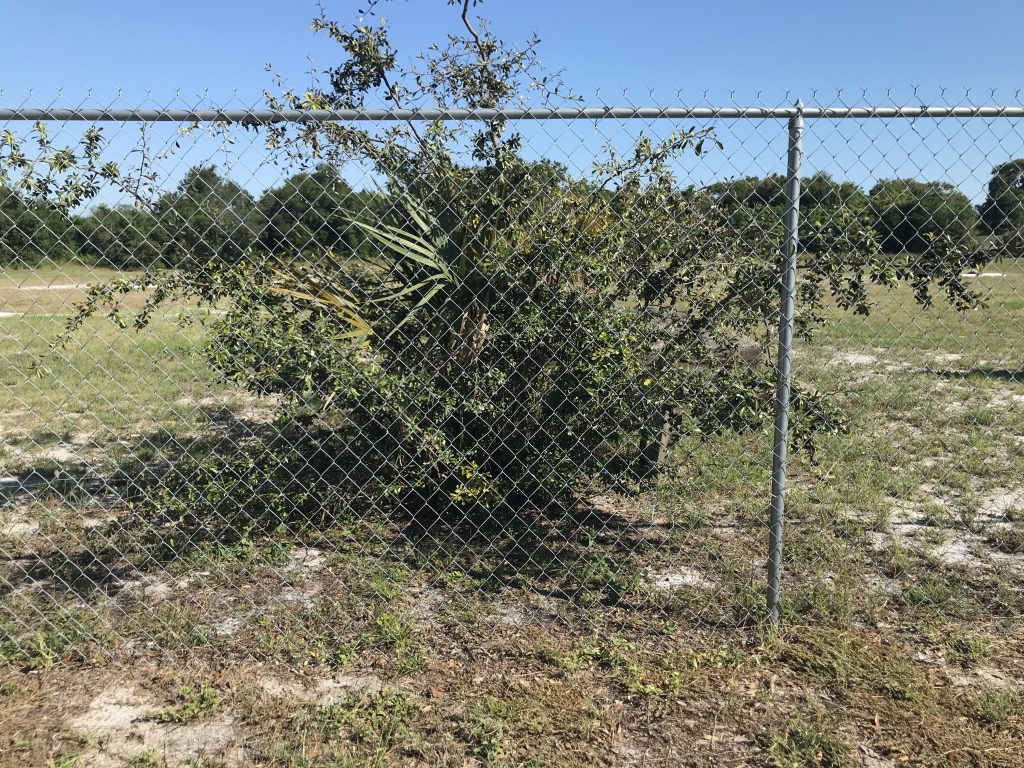
It’s a Sideroxylon but which one? Photo by Green Deane
Old identification problems don’t go away. They just remain unsolved. Recently while stopping at an intersection near a gated cemetery (it must be exclusive) I noticed a shrub that looked familiar (photo above.) Actually what caught my eye was the amount of fruit.
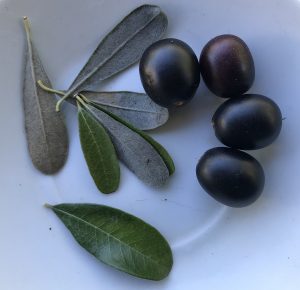
This underleaf is gray. Silver? Photo by Green Deane
I returned twice the next day to take pictures and try to make an identification. The genus is fairly easy, Sideroxylon, which I originally learned in the early 90’s as Bumilia. The headache is which species is it because some of them are (barely) edible and some aren’t. The species don’t vary much: They have thorns, alternating leaves, sometimes in whorls, about an inch long, a third of an inch wide, dark green and smooth on top, hairy underneath. And that is where I hit two road blocks. The species I want to call it, S. tenax — my guess 24 years ago — is supposed to have brown hair… maybe… I think my leaves are gray (see photo right.) The other issues is the subjective difference between “copious” hair vs “densely matted hair.” I am not sure what the difference is,
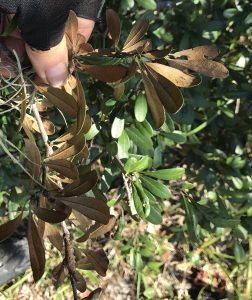
This underleaf is brown. Copper? Photo by Green Deane
Leaf length rules out S. lyciodes, arrangement of the leaves does not rule out S. reclinata. As for S. tenax one authority says the underside of the leaf is covered with “dense, silvery, golden, coppery or brownish pubescence, often contrasting sharply with the dark green upper surfaces.” Another says “narrowly oval leaves have a dense coat of silvery to rusty-brown hairs on the undersides.” By chance yesterday while looking for pawpaws I found another Sideroxylon (photo left) with definitely brown leaves underneath. So within three days I find two examples of a genus I have not seen in 24 years and I can’t tell if they are the same species, a variation of one species, or two species. If I want to grow it from seed I have to “scarify in concentrated sulfuric acid for 20 minutes followed by stratification for 30-60 days at 41 degrees.” That means battery acid. I have some someplace. (They sell it by the half gallon at auto stopes and it lasts you a lifetime.) After soaking in acid — replicating the bird’s gut — the seeds go into the fridge for a couple of months. It’s an experiment in progress. Maybe a decade from now I will still have a mystery shrub but one of my own. You can read more about the genus here.
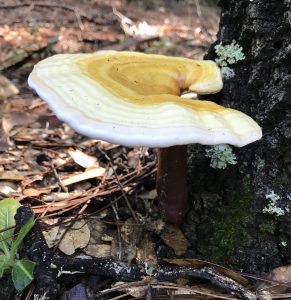
We have several species Reishi mushrooms in North American. This one is Ganoderma curtisii if growing on hardwood, G. meredithiae if growing on pines . Photo by Green Deane
The question isn’t whether Reishi mushrooms grow in North America. The question is what to call them. Some would argue there are only six species of Reishi mushrooms on this continent. Others say many more. Just as the botanical world is in DNA flux so to is the fungal realm. Regardless of the species the Reishis are all Ganodermas, a genus name that that always suffers from translation. One sees Ganoderma translated as “shiny skin.” That’s not exactly right. In Greek it actually means “polished leather” like shoes or boots. When I think of shiny skin I think of what my fingers and toes looked like after getting chilblains or frost bite. My skin was shiny. It did not look like polished leather. By the way once you get chilblains you always have them. I can go into a well air-conditioned building in Florida and my fingers and toes will ache from frozen nights spent ice skating 65 years ago.
Pictured above right is Ganoderma curtisii, an easy to identify Reishi mushroom. It’s almost always shaped like a P, or a golf club, some say a cobra. All the ones I have spied have been growing on oaks. In 1988 it was decided that a slightly different species grows on Pines especially in the Gulf Coast states. That is G. meredithiae name for fungal expert Meredith May Blackwell. As for use my herbalist friends tell me our Reishi mushrooms can be used like their more famous Asian relatives and do stimulate the immune system. Consult your local herbalist for details.
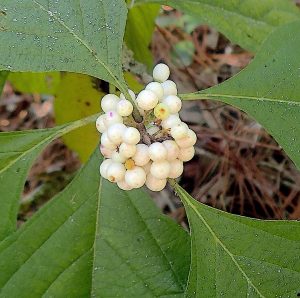
White Beautyberries. Photo by Green Deane
Are the berries to the left edible or not? Ninety-nine plus percent of white berries are not edible. White berries are a huge warning flag saying stay away. But there are exceptions. I can think of a few wild white berry species in the world that are edible, some in North America and one in Africa. But what of the berries pictured left? They are white American Beautyberries. Usually they are magenta when ripe. These are stark white. I have eaten a few. They taste like the colored ones. A few years ago I had a woman in New Jersey write to me and report she eats them all the time and makes jelly out of them. That’s not an official endorsement but it is about as close as one can get to knowing if they are edible. There are at least four species of Beautyberries that can spontaneously produce white berries, and there might be a man-made cultivar or two. The shrub at left had magenta colored berries for several years then went white for one year then back to colored berries. To read more about them click here.
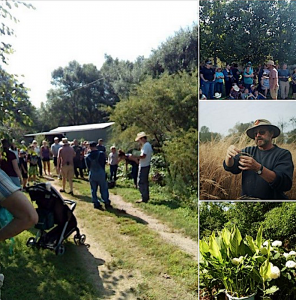
Teaching in South Carolina. Photo by Donna Putney
Foraging Classes: The weekend after next I will be in South Carolina for two days of classes at an herbal festival. There will also be an herbal festival with a variety of vendors. There’s RV parking available but no hook ups. This weekend I will be in Largo, at a park that used to be a farm, and Sunday in Gainesville which includes plants along the Hawthorn Bike Trail.
Saturday October 2nd, Eagle Park Lake, 1800 Keene Road, Largo, FL 33771. 9 a.m. to noon, meet at the pavilion near the dog park.
Sunday October 3rd, Boulware Springs Park, 3420 SE 15th St., Gainesville, FL 32641. Meet at the picnic tables next to the pump house. 9 a.m. to noon.
Saturday October 9th, Honea Path, South Carolina, classes at 9 a.m. and 1 p.m. each day. 1624 Taylor Road Honea Path, SC 29654. You can contact me or Putney Farm@aol.com
Sunday October 10th, Honea Path, South Carolina, classes at 9 a.m. and 1 p.m. each day. 1624 Taylor Road Honea Path, SC 29654, You can contact me or Putney Farm@aol.com
Saturday October 16th, Red Bug Slough Preserve, 5200 Beneva Road, Sarasota, FL,. 9 a.m. to noon.
Sunday October 17th, Mead Garden: 1500 S. Denning Dr., Winter Park, FL 32789. Meet at the bathrooms. 9 a.m. to noon.
Saturday October 23rd, Dreher Park, 1200 Southern Blvd., West Palm Beach, 33405. 9 a.m. to noon, meet just north of the science center.
Sunday October 24th, Bayshore Live Oak Park, Bayshore Drive. Port Charlotte. 9 a.m. to noon, meet at the parking lot of Bayshore and Ganyard.
For more information, to pre-pay or sign up go here.
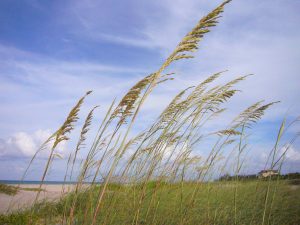
Edible Sea Oats are protected but their edible relative Wood Oats are not. Photo by Green Deane
The grain pictured left, Uniola paniculata, is edible though it does not produce a lot of seed. It is also protected. It’s not protected because it is rare. In fact it’s very common. But the plant’s roots helps keep Florida’s coastal dunes in place thus Sea Oats are protected. I have known some folks to grow Sea Oats in their backyard as a long-lived perennial grass. They are very drought tolerant and highly regarded by browsing animals such as deer but are lowly regarded by grazing animals such as cows. As Sea Oats are protected you might want to find a similar looking relative in the forests of Florida. They are called… Wood Oats… not too imaginative. Wood Oats are edible as well and not protected. Use them as you would cultivated oats. They are easy to identify: They look like Sea Oats just in the wrong place. To read about Sea Oats click here.

Green Deane videos are now available on a USB.
My nine-DVD set of 135 videos has been phased out and replaced by a 150-video USB. The USB videos are the same videos I have on You Tube. Some people like to have their own copy. The USB videos have to be copied to your computer to play. If you want to order the USB go to the DVD/USB order button on the top right of this page or click here. That will take you to an order form. I’d like to thank all of you who ordered the DVD set over the years which required me to burn over 5,000 DVDs individually.

Green Deane Forum
Want to identify a plant? Perhaps you’re looking for a foraging reference? You might have a UFO, an Unidentified Flowering Object, you want identified. On the Green Deane Forum we — including Green Deane and others from around the world — chat about foraging all year. And it’s not just about warm-weather plants or just North American flora. Many nations share common weeds so there’s a lot to talk. There’s also more than weeds. The reference section has information for foraging around the world. There are also articles on food preservation, and forgotten skills from making bows to fermenting food.
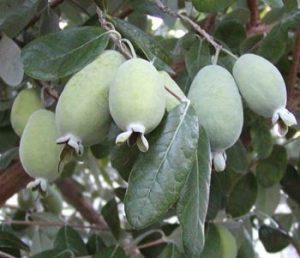
Ripe and unripe Pineapple Guava looks the same. They just soften. Photo by Green Deane
What is season locally? Persimmons are definitely available and some Jambul trees are still dropping fruit. Ground cherries are ripening and some American Lotus are producing seed heads as are wood/Sea Oats. Regular and ornamental bananas are ripening. Interestingly September is the month Pineapple Guava usually ripen but this year it might be in October. I know of two trees, 150 miles apart, and both with unripe fruit as of this writing.
This is my weekly free newsletter #476. If you want to subscribe to this free newsletter you can find the sign-up form in the menu at the top of the page.
To donate to the Green Deane Newsletter click here.


Green Deane,
I wanted to let you know about a couple of things. First, Chrome doesn’t like your registration link in this week’s blog post (9-28-2021) re: the workshops in FL. The error message said, “This ad used too many resources for your device, so Chrome removed it.” I.e., it didn’t go through. I wonder if this might be happening for a lot of other people, too. (Please note: I’m in MN and not going to attend–besides being a low-level/noob forager, I’m a tech nerd and was just curious what the registration system was and looked like, so I tried to click through.)
Another thing–there’s a persistent issue with “Not Secure” appearing in the browser field with the URL on your blog. The easy solution to this is to purchase an SSL (a security feature; it stands for “secure socket layer”) via whoever either registers your domain name -or- possibly, depending on if they offer it, through your website (blog) host. It shouldn’t cost you more than $20. Google significantly knocks points off organic-search access to any website without an SSL, and eventually may block direction to such a site completely. (An SSL offers some protection not only to you/your site, but also to your site’s users.)
I appreciate your site, especially so when the plants featured are ones that also grow up north, here.
–Kathy
Thanks for writing. As I am excessively computer challenges I know nothing about SSL but I will look into it. As for the a registration link…. in the Sept 28 newsletter … I don’t know what that is. There is a link to the classes page but there is no registration per se. All folks do is send me an email.